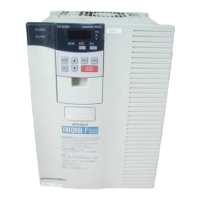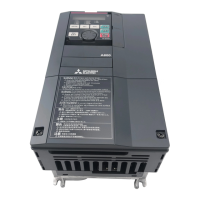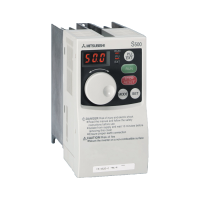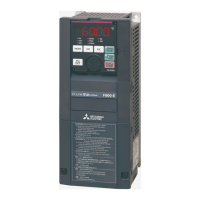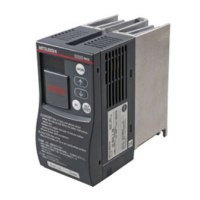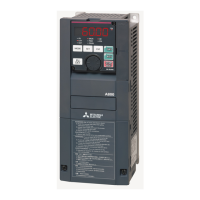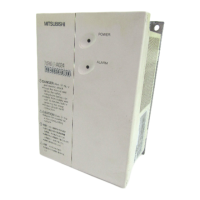22
Wiring
2.4.7 Safety stop function
(1) Description of the function
The terminals related to the safety stop function are shown below.
Refer to page 15 for the rated specification of each terminal.
∗1 In the initial status, terminal S1 and S2 are shorted with terminal SC by shortening wire. Remove the shortening wire and connect the safety relay module
when using the safety stop function.
∗2 In the initial setting, safety monitor output signal (SAFE signal) is assigned to terminal SO. The function can be assigned to other terminals by setting "80
(positive logic) or 180 (negative logic)" to any of Pr. 190, Pr. 192 or Pr. 197 (Output terminal function selection). ( Refer to Chapter 4 of the Instruction Manual
(Applied))
∗3 In the initial setting, inverter running (RUN signal) is assigned to terminal RUN. Set "81" to Pr. 190 RUN terminal function selection to assign SAFE2 signal. The
function can be assigned to other terminals by setting "81 (positive logic) or 181 (negative logic)" to any of Pr. 190, Pr. 192 or Pr. 197 (Output terminal function
selection). ( Refer to Chapter 4 of the Instruction Manual (Applied))
(2) Wiring connection diagram
To prevent restart at fault occurrence, connect terminals RUN (SAFE2 signal) and SE to terminals XS0 and XS1, which are
the feedback input terminals of the safety relay module.
By setting Pr.190 RUN terminal function selection = "81 (SAFE2 signal)", terminal RUN is turned OFF at fault occurrence.
Term inal
Symbol
Description
S1∗1 For input of safety stop channel 1. Between S1 and SC / S2 and SC
Open: In safety stop mode.
Short: Other than safety stop mode.
S2
∗1 For input of safety stop channel 2.
SO
∗2
SAFE
signal
For output of safety stop condition.
The signal is output when inverter output is shut off due to the safety stop
function.
OFF: Drive enabled
ON: Output shutoff, no fault
SC Common terminal for S1,S2,SO signals. (SC is connected terminal SD internally.) ----------
RUN
∗3
SAFE2
signal
As output for failure detection and alarm.
The signal is output while safety circuit fault (E.SAF) is not activated.
OFF: Safety circuit fault (E.SAF)
ON: Status other than Safety circuit
fault (E.SAF)
SE Common terminal for open collector outputs (terminal RUN) ----------
NOTE
y Use SAFE signal for the purpose to monitor safety stop status. SAFE signal cannot be used as safety stop input
signal to other devices (other than the safety relay module.)
y SAFE2 signal can only be used to output an alarm or to prevent restart of an inverter. The signal cannot be used as
safety stop input signal to other devices.
NOTE
y Changing the terminal assignment using Pr. 190, Pr. 192, Pr. 197 (output terminal function selection) may affect the other
functions. Make setting after confirming the function of each terminal.
S2
S1
SC
Inverter
START/RESET
+24V
Emergency stop button
QS90SR2SN-Q
K1
X0 X1
COM0
COM1
24G
Internal
Safety
Circuit
XS0
XS1
Z10
Z00
Z20
Z11 Z01 Z21
K2
DC24V
RUN (SAFE2)*1
R S T
U V W
MITSUBISHI MELSEC Safety relay module
IM
SE
STF*2
STR(STOP)*2
STF
STOP
SD
Output
shutoff
circuit
I/O control
SO (SAFE)*1
monitor
*1
*2
Pr. 178 = "60 (initial value)"
Pr. 179 = "25"
Pr. 190 = "81"
Pr. 197 = "80 (initial value)"
Output signals differ by the setting of Pr. 190, Pr. 192
and Pr. 197 (Output terminal function selection).
Input signals differ by the setting of Pr. 178 to Pr. 182
(Input terminal function selection).

